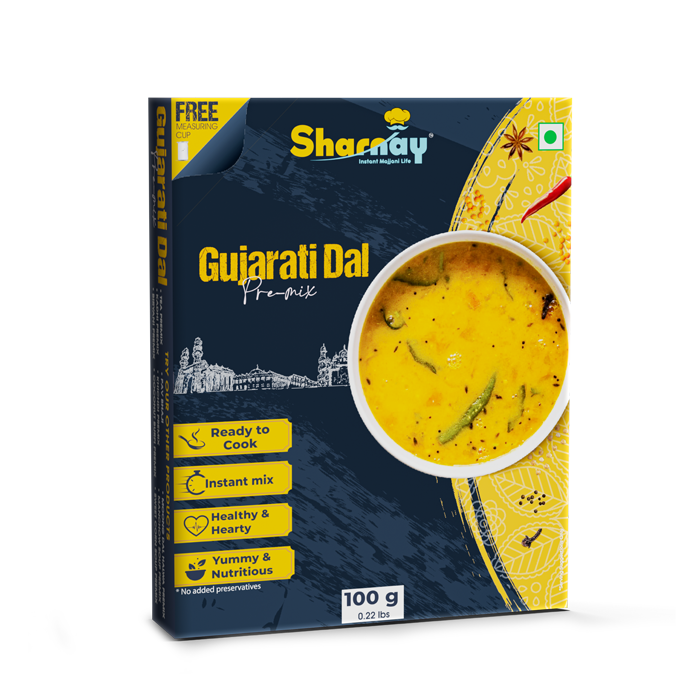
Introduction
Gujarati cuisine is renowned for its vibrant flavors and wholesome ingredients, and one dish that embodies this essence is Gujarati Dal. This beloved lentil soup is a staple in many Gujarati households, cherished for its delicate balance of sweet and tangy flavors. Packed with essential nutrients and easy to prepare, Gujarati Dal is a delightful and comforting addition to any meal. In this article, we explore the traditional recipe of Gujarati Dal, step by step, along with its cultural significance and health benefits.
A Cultural Connection
- The Heart of Gujarati Cuisine
Dal holds a special place in Gujarati cuisine as it is an integral part of the daily meal. Whether served with steaming rice or soft rotis, Gujarati Dal complements various dishes, enhancing the overall dining experience. Its preparation methods and choice of spices reflect the rich culinary heritage of Gujarat, making it a favorite among locals and food enthusiasts worldwide.
- A Symbol of Warmth and Hospitality
In Gujarat, serving Dal to guests is considered an act of warm hospitality and respect. The simplicity of the dish is symbolic of the Gujarati culture, where emphasis is placed on sharing wholesome and flavorful meals with friends and family.
Ingredients for Gujarati Dal
- Toor Dal (Pigeon Pea Lentils)
The star ingredient of Gujarati Dal is Toor Dal, also known as arhar or pigeon pea lentils. These lentils add a creamy texture and earthy flavor to the dish, making them an essential component of this preparation.
- Aromatic Spices and Seasonings
The tempering or tadka plays a vital role in elevating the taste of Gujarati Dal. Mustard seeds, cumin seeds, asafoetida (hing), dried red chilies, and curry leaves are commonly used to add depth and aroma to the dal.
- Tomatoes and Jaggery
The combination of ripe tomatoes and jaggery (unrefined cane sugar) gives Gujarati Dal its signature sweet and tangy taste. The tomatoes provide acidity, while the jaggery balances it with a hint of sweetness.
- Turmeric and Green Chillies
Turmeric powder adds a golden hue to the dal while providing its anti-inflammatory properties. Green chilies impart a subtle spiciness, which can be adjusted according to individual preferences.
Step-by-Step Recipe
- Ingredients (Serves 4):
- 1 cup Toor Dal (pigeon pea lentils)
- 2 medium-sized ripe tomatoes, finely chopped
- 2-3 green chilies, slit lengthwise
- 1 tablespoon grated jaggery (adjust to taste)
- 1 teaspoon turmeric powder
- Salt to taste
- Tempering (Tadka):
- 2 tablespoons ghee (clarified butter)
- 1 teaspoon mustard seeds
- 1 teaspoon cumin seeds
- Pinch of asafoetida (hing)
- 2 dried red chilies
- A few curry leaves
- Preparation:
- Rinse the Toor Dal thoroughly under running water until the water runs clear. Soak the dal in water for about 30 minutes before cooking to shorten the cooking time.
- In a pressure cooker, add the soaked dal, chopped tomatoes, green chilies, turmeric powder, and a pinch of salt. Pour in 3-4 cups of water and pressure cook the dal until it becomes soft and well-cooked. Depending on the pressure cooker, this may take 10-15 minutes.
- Once the dal is cooked, mash it using a spoon or a whisk to achieve a creamy consistency. Add more water if needed to reach the desired consistency.
- Now, add the grated jaggery to the dal, stirring well to incorporate the sweetness evenly.
- In a separate small pan, heat ghee over medium heat for tempering. Add mustard seeds and let them crackle. Then, add cumin seeds, asafoetida, dried red chilies, and curry leaves, allowing them to release their flavors and aromas.
- Pour the tempering over the dal and give it a gentle stir to combine all the flavors.
- Serving Suggestions:
Gujarati Dal is best enjoyed with steamed basmati rice or soft phulkas (Indian flatbreads). Garnish the dal with chopped cilantro leaves for a burst of freshness. A side of mixed vegetable sabzi or a traditional Gujarati thali complete the meal perfectly.
Health Benefits
- Protein-Rich
Toor Dal is an excellent source of plant-based protein, making Gujarati Dal a valuable addition to vegetarian and vegan diets. Protein is essential for muscle repair and growth, as well as overall body functions.
- Rich in Fiber
Lentils are high in dietary fiber, promoting healthy digestion and aiding in weight management. The soluble fiber in dal helps regulate blood sugar levels and cholesterol levels.
- Essential Vitamins and Minerals
Gujarati Dal provides essential vitamins like vitamin C and B-complex vitamins, as well as minerals like iron, magnesium, and potassium. These nutrients are vital for maintaining overall health and well-being.
Conclusion
Gujarati Dal is more than just a simple lentil soup; it represents the heart and soul of Gujarati cuisine and culture. Its sweet and tangy flavors, combined with the goodness of lentils and aromatic spices, create a wholesome and delightful meal. As you savor a bowl of Gujarati Dal, you not only relish its comforting taste but also connect with the traditions and warmth that this dish embodies. Whether you prepare it for a family dinner or to welcome guests, Gujarati Dal will continue to be cherished and celebrated as a timeless classic in the culinary world.
